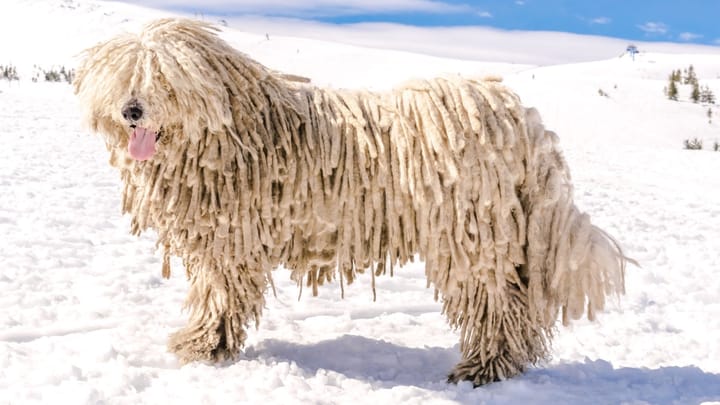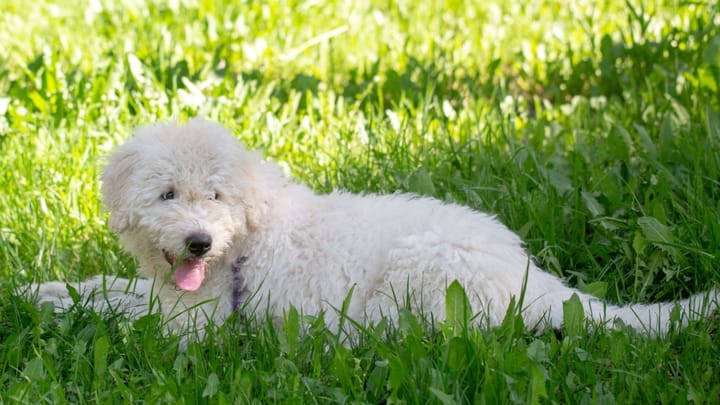Komondor
Other names : Hungarian Sheepdog, Mop Dog, Hungarian Commonmop


Right, this is the one. The dog you’ve been seeing around town. The one that causes small children to stop and drop their lollipops. But while yes, this dog is a big mop on legs, and at least twice as adorable in person as seen from afar, she is also a serious working dog in her own right: a shepherd and a fierce guard, whose flowing cords disguise her strength and vigour. Thus, she may be a mop but she’s nobody’s broom to push around, and without adequate training this large and determined dog can become quite a handful. Properly raised, however, she will become an affectionate and striking member of the family and a great help around small domestic spillages.
|
Life expectancy |
The Komondor has a life expectancy of between 10 and 12 years |
|
Size |
Large
|
|
Adult size |
Female
Between 26 and 28 in
Male
Between 28 and 31 in
|
|
Adult weight |
Female
Between 88 and 110 lb
Male
Between 110 and 132 lb
|
|
Coat colour
Ivory. |
Sand White |
|
Type of coat
Coarse upper coat, tending towards corded; fine undercoat. |
Long |
|
Eye colour
Dark brown. |
Brown
|
There are only a few dozen of these dogs in the UK so tracking down a pup can take a while.
More details about the Komondor
Komondor: Origins and history
Known as a Hungarian Sheepdog, her ancestors were brought to Hungary in the middle-ages by the Cumans, from whom she takes her name and at whose graves her ancestors’ remains have been found. Before that, her heritage seems to have been Tibetan. She has been a popular worker in Hungary for many centuries, guarding rather than herding sheep. It is said that many of her kind perished at the hands of the invading Nazis because no Komondor house could be taken with this fierce protector still alive.
Physical characteristics of the Komondor
While the Hungarian Sheepdog is known for her mop-like appearance, her coat may appear more or less smooth, wavy, or matted according to the individual; and those cords can take several months from puppyhood to develop. All the same, you’re looking at one hairy dog, whose hair at its shortest is 10cm (ears, neck, and limbs) while nearing 30cm on the croup. So striking is her hair-do that many neglect to ponder, or simply can’t imagine, what’s going on underneath. What you would find were you to look is a broad, domed head, a muscled neck in perfect line to her back, a broad chest, muscled torso, big bones, yet a light gait.
FCI classification of the Komondor
-
Group 1 - Sheepdogs and Cattledogs (except Swiss Cattledogs)
-
Section 1 : Sheepdogs
Komondor: Characteristics
Komondor: Behaviour
Training a Komondor
The Komondor requires firm training as she is a powerful dog who can be obstinate and independent-minded.
Komondor: Lifestyle
Breed compatibility Komondor
Komondor: Purchase price
You can expect to pay upwards of £1,000 for a well-bred KC registered puppy. Looking after a dog of this size typically costs between £90 to £160 a month, including food, medical/insurance, and incidental expenses.
Komondor: Grooming
While this uniquely-carpeted dog may not require as frequent grooming as you may imagine (and absolutely no brushing) she needs to bathed now and then and have her cords divided and cared for a few times a year.
Komondor: Health
This dog keeps generally good health. Her average life expectancy is 11 years.
She is a sturdy dog, but suffers from several health conditions.
As you can imagine, she soon becomes uncomfortable in hot weather.
She is perfectly designed to work hard in very cold weather.
She is not a greedy dog, and not predisposed to put on weight.
- CHD
- Gastric torsion
- Cataracts
- Skin problems (sebaceous cysts, dermatitis)
- Trichoepithelioma (skin tumor)
- Hip dysplasia
- Entropion





